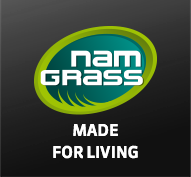Installing / fitting artificial grass
It has never been easier to install artificial grass. This manual, made by Namgrass artificial grass, shows you how our installers fit your artificial lawn.
Preparations
In order to install artificial grass, a smooth, stable base with proper drainage is required.
Garden
The best base for artificial grass is cement stabilised sand, although it is not always necessary. The big advantage of a sand-cement base is that weeds and moles do not stand a chance against it.
If your garden has a solid, level base without moles,... the artificial grass can be installed directly on the ground. First remove the top layer, level and smoothen it with sand to about 1.5 to 2 cm below the required level. Then compact the surface to finish the preparation of your garden for the installation of artificial grass.
Put ekki posts in every corner and at every 2 metres along the edges. They need to be level with the surface in order to fix the geotextile and the artificial grass.
Should you wish to keep the existing paved surface, then make sure that there are no pits, tears or other irregularities.
Balcony / Roof terrace
In order to install artificial grass on a balcony or roof terrace, good drainage is imperative. To this end, a white geotextile with drainage studs is laid out. It functions as a drainage mat and as a buffer against too high temperatures from the sun.
Installation
Geotextile
A geotextile is laid out underneath the artificial grass. It distributes the pressure, it helps prevent weeds and it reduces noise if the subsoil is cement stabilised sand. Roll out the geotextile, cut it to size and fix it to the ekki posts with nails. Tip: sprinkle the geotextile with water. This way, it will stick to the base and it won’t move when you unroll the grass over it.
After the geotextile has been cut and laid out, the artificial grass mats can be unrolled. Use the same pile direction throughout the whole project. The best pile direction is the one pointing to the place from which you look at the garden most. The best effect is achieved when looking into the artificial grass pile (the pile direction pointing to you). Avoid having to look at the back of the pile.
Cutting
The cutting to size and the finishing of the edges of the artificial grass mat is preferably done with a strong, sharp knife (e.g. a Stanley knife).
First cut the edges off the backing. You can use the last but one row of fibres as a guide. It is also advisable to cut diagonally, at the back, between the loops of the grass fibres to avoid any damage to the fibres.
When cutting to size, always allow for an overlap of about 5 cm. This excess can be removed at the end of the installation of the artificial grass.
Put the seams together at a distance of 1 mm: if they are too far apart, you will see the foundation and if they are too close together, the grass won’t be on the ground anymore... Do this with all seams.
Gluing
Put tape underneath the seams.
When the strips have been cut and laid out in the required position, the dual component glue can be mixed with a rod mixer. The glue should be divided into smaller portions to make its distribution on the tape easier.
Applying the glue is done with a glue spatula. We recommend the use of plastic gloves for this.
If too much glue is applied, it will leave residues through the seams and the perforations between the fibres, so it is important that any glue residues are removed instantly.
Please note: the glue will harden fast and it cannot be used when it rains!
The seams are then closed and pressed down strongly. Closing the seams is easier with two people, so the artificial grass can be closed like a zipper.
After closing the seams, walk along the complete length of them for at least three times.
Take small steps to ensure the complete seam is pressed down firmly.
If you follow this manual step by step, you should be able to install artificial grass in your garden or on your terrace yourself.
